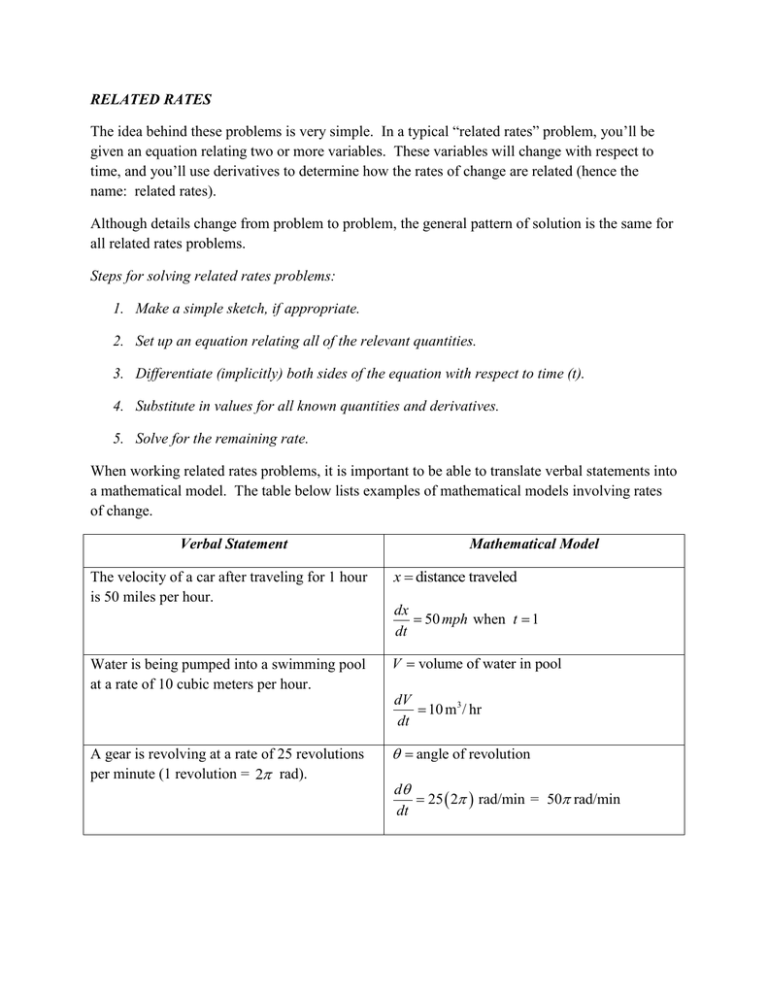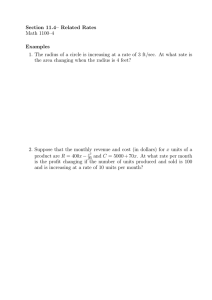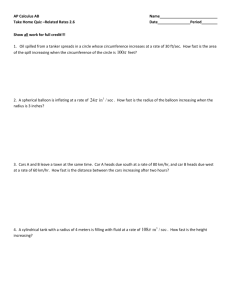RELATED RATES.doc
advertisement

RELATED RATES The idea behind these problems is very simple. In a typical “related rates” problem, you’ll be given an equation relating two or more variables. These variables will change with respect to time, and you’ll use derivatives to determine how the rates of change are related (hence the name: related rates). Although details change from problem to problem, the general pattern of solution is the same for all related rates problems. Steps for solving related rates problems: 1. Make a simple sketch, if appropriate. 2. Set up an equation relating all of the relevant quantities. 3. Differentiate (implicitly) both sides of the equation with respect to time (t). 4. Substitute in values for all known quantities and derivatives. 5. Solve for the remaining rate. When working related rates problems, it is important to be able to translate verbal statements into a mathematical model. The table below lists examples of mathematical models involving rates of change. Verbal Statement Mathematical Model The velocity of a car after traveling for 1 hour is 50 miles per hour. x distance traveled Water is being pumped into a swimming pool at a rate of 10 cubic meters per hour. V volume of water in pool dx 50 mph when t 1 dt dV 10 m3 / hr dt A gear is revolving at a rate of 25 revolutions per minute (1 revolution = 2 rad). angle of revolution d 25 2 rad/min = 50 rad/min dt Example 1 Suppose x and y are both differentiable functions of t and are related by the equation y x 2 3 . Find dy dx 2 when x 1 . when x 1 given that dt dt Example 2 A circular pool of water is expanding at a constant rate of 16 square inches per second. At what rate is the radius expanding when the radius is 4 inches? Example 3 A 25-foot long ladder is leaning against a wall and sliding toward the floor. If the foot of the ladder is sliding away from the base of the wall at a rate of 15 feet per second, how fast is the top of the ladder sliding down the wall when the top of the ladder is 7 feet from the ground? 25 ft y(t) x(t) Example 4 A spherical balloon is expanding at a rate of 60 inches3 per second . How fast is the surface of the balloon expanding when the radius of the balloon is 4 inches? Example 5 An underground conical tank, standing on its vertex, is being filled with water at the rate of 18 cubic feet per minute. If the tank has a height of 30 feet and a radius of 15 feet, how fast is the water level rising when the water is 12 feet deep? r(t) h(t) Example 6 A rocket is rising vertically at a rate of 5,400 miles per hour. An observer on the ground is standing 20 miles from the rocket’s launch point. How fast (in radians per second) is the angle of elevation between the ground and the observer’s line of sight of the rocket increasing when the rocket is at an elevation of 40 miles? (Notice that the velocity is given in miles per hour and the answer asks for radians per second. In situations like this one, you have to be sure to convert the units properly.) Extra Practice: 1. A pebble is dropped into a calm pond, causing ripples in the form of concentric circles. The radius r of the outer ripple is increasing at a constant rate of 1 foot per second. At the instant when the radius is 4 feet, at what rate is the total area of the disturbed water changing? 2. Air is being pumped into a spherical balloon at a rate of 4.5 cubic feet per minute. Find the rate of change of the radius when the radius is 2 feet. 3. An airplane is flying on a flight path that will take it directly over a radar tracking station. If s is decreasing at a rate of 400 miles per hour when s = 10 miles, what is the speed of the plane? x(t) alt. 6 miles s(t) (t) 4. A television camera at ground level is filming the lift-off of a space shuttle that is rising vertically according to the position equation s 50t 2 , where s is measured in feet and t is measured in seconds. The camera is 2000 feet from the launch pad. Find the rate of change in the angle of elevation of the camera at 10 seconds after lift-off. Practice Set 1. Oil spilled from a tanker spreads in a circle whose circumference increases at a rate of 40 ft/sec. How fast is the area of the spill increasing when the circumference of the circle is 100 feet? 2. A spherical balloon is inflating at a rate of 27 in 3 / sec . How fast is the radius of the balloon increasing when the radius is 3 inches? 3. Cars A and B leave a town at the same time. Car A heads due south at a rate of 80 km/hr and car B heads due west at a rate of 60 km/hr. How fast is the distance between the cars increasing after three hours? 4. A cylindrical tank with a radius of 6 meters is filling with fluid at a rate of 108 m3 / sec . How fast is the height increasing? 5. The sides of an equilateral triangle are increasing at the rate of 27 in/sec. How fast is the triangle’s area increasing when the sides of the triangle are each 18 inches long? 6. An inverted conical container has a diameter of 42 inches and a depth of 15 inches. If water is flowing out of the vertex of the container at a rate of 35 in 3 / sec , how fast is the depth of the water dropping when the height is 5 inches? 7. A boat is being pulled toward a dock by a rope attached to its bow through a pulley on the dock 7 feet above the bow. If the rope is hauled in at a rate of 4 ft/sec, how fast is the boat approaching the dock when 25 feet of rope is out? 8. A 6-foot-tall woman is walking at the rate of 4 ft/sec away from a street lamp that is 24 feet tall. How fast is the length of her shadow changing? 9. The voltage, V, in an electrical circuit is related to the current, I, and the resistance, R, by the equation V IR . The current is decreasing at 4 amps/ sec as the resistance increases at 20 ohms / sec . How fast is the voltage changing when the voltage is 100 volts and the current is 20 amps? 10. The minute hand of a clock is 6 inches long. Starting from noon, how fast is the area of the sector swept out by the minute hand increasing, in in 2 / min , at any instant? (The formula for the area of the sector of a circle is A angle of the sector of the circle measured in radians.) 1 2 r , where is the central 2 ANSWERS 1. 2000 ft 2 / sec 2. 3 in / sec 4 3. 100 km / hr 4. 3 m/s 5. 243 3 in 2 / sec 6. 5 in / sec 7 7. 25 ft / sec 6 8. 4 ft / sec 3 9. 380 volts/sec 10. 3 in 2 / min 5



